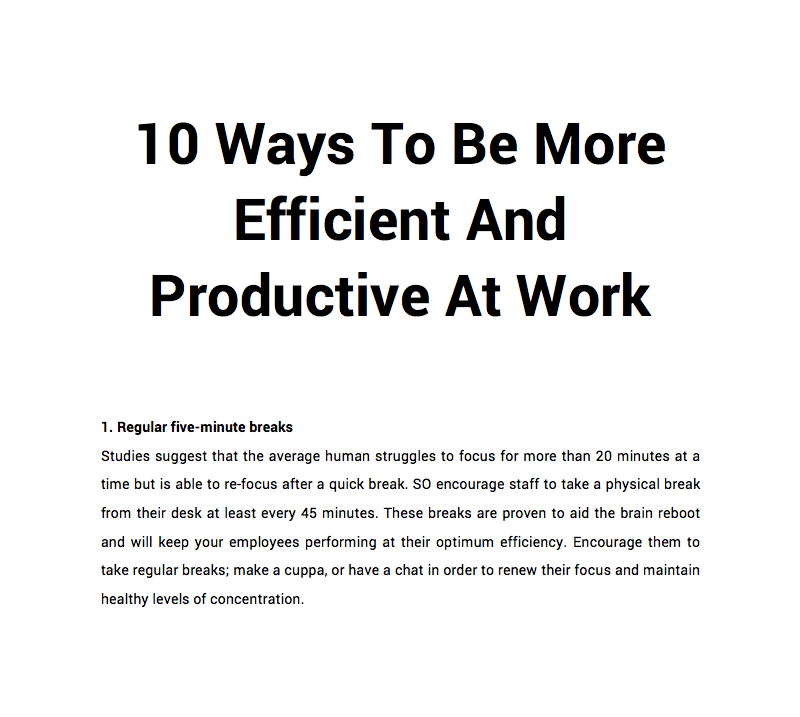
10 tips to keep you and colleagues motivated during Summer
Efficiency is important because it is the key to a functional business. Our 10 step guide offers practical advice on how to boost workforce efficiency.
1. Regular five-minute breaks
Studies suggest that the average human struggles to focus for more than 20 minutes at a time but is able to re-focus after a quick break. SO encourage staff to take a physical break from their desk at least every 45 minutes. These breaks are proven to aid the brain reboot and will keep your employees performing at their optimum efficiency. Encourage them to take regular breaks; make a cuppa, or have a chat in order to renew their focus and maintain healthy levels of concentration.
2. Self-manage
Ask your staff to review their to-do list throughout the day. Reprioritising the urgency of various jobs throughout the course of the day will not only help them to manage upwards and take charge of their own planning, but it will prevent them from just ‘doing’.
3. Team huddles
As the week progresses, your team may gradually lose focus on the week’s shared objectives. In these instances, you can lose precious work time to tasks that are no longer relevant due to changing priorities. A short team huddle each morning before starting or resuming work on a particular project will keep your team focused on working to a clear end goal. Answering any questions prior to beginning work should also reduce the number of internal emails you receive throughout the session.
4. Stand up
Standing desks offer both health and psychological benefits. Standing for periods of time at work not only boosts your metabolism helping you to burn calories throughout the day, but is also thought to reduce the risk of diabetes and heart disease. This approach to efficient working is also proven to increase blood flow to the brain, resulting in improved performance and engagement. If you don’t have the budget for standing desks, take every opportunity to get your staff on their feet; during daily huddles or informal meetings.
5. Power hour
At some stage, every one of us is guilty of putting off the jobs we don’t want to do. Whether the job is boring, time consuming, or you’re just a bit scared to tackle it, by putting it to the back of the pile all you are doing is delaying the inevitable. At some point, it needs to be done. The daily ‘power hour’ is a concept designed with those specific jobs in mind. Get your staff to set aside an hour each day to crack through their admin, so they can get them ticked off the list and move on to the more enjoyable tasks.
6. Hot desk
Enable your staff to have a change of scenery by keeping a hot desk free, on a first come first served basis. Switching between desks stimulates new perspectives and levels of concentration, much in the same way that taking regular breaks does. Never underestimate the power of a new view.
7. Brainstorm preparation
Brainstorms are a really useful tool for generating new ideas but it can sometimes take a while for the creative juices to start flowing. Give your staff 24 hours’ brainstorm warning so they can mull over some ideas prior to the meeting, to keep the session efficient, and to schedule.
8. Timesheets
Have your employees keep a log of where their time is going each day. This will help you to identify problem areas and see what tasks need more time allocated to them as well as places where time may be being wasted. Timesheets will also identify if members of your staff are being overstretched or have too many tasks on the go at one time. After a month’s worth of data has been collected you can analyse the information to address any areas that are impacting on efficiency.
9. Shut the office at 5.30pm
British workers have developed a bad habit for working longer than actually necessary. By closing the office at 5.30pm each day you not only provide your staff with a better work-life balance, but also ensure your team are working as efficiently as possible to complete their tasks ahead of closing time.
10. Trial and feedback
It takes 21 days to break a bad habit. Have your staff implement these top tips for a month then ask them feedback once the four-week trial is up. Do you staff feel they are working more efficiently? Which tips worked well for you and your team? Are your staff happier and more motivated, knowing they can achieve the same in less time?
Download our printable guide below:
Download ← Back

